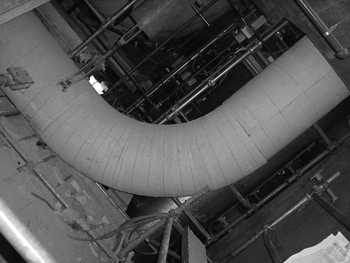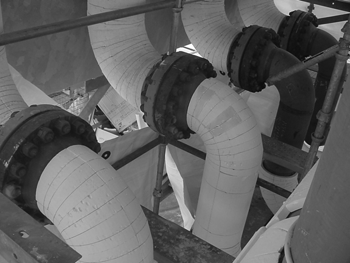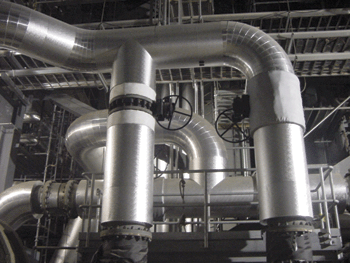An Inside Look at Insulating the Largest Power Plant in the U.S.
Very few end-users understand the complexities of an insulation project. Nor should they, as they have their own share of ‘complexities’ to deal with. However, this article will give those who are interested a peek at what goes on behind the scenes of a very complex insulation project like this one at the Mystic Power Plant in Everett, Mass.
What is it like to be involved in the biggest insulation project your firm has ever undertaken? Just ask Ted Brodie, president and CEO of New England Insulation Company (NEIC) of Canton, Mass., who said, "Not only was it the biggest job we’ve ever been involved with in terms of volume, but it was the largest power plant under construction in the United States at the time." The project is the Mystic Power Plant, a combined cycle power generation facility, located on 19 acres of urban landscape along the Mystic River in Everett, Mass. Construction of the two 800-megawatt, natural gas-fueled power generators is complete. Unit 1 commenced operation in June and Unit 2 in July 2003. Because the power market in Massachusetts is deregulated, the electricity produced by the Mystic plant is sold on the open market to electrical grid utilities supplying residential, commercial and industrial customers.
Site Constraints Posed a Challenge
According to Blake Underhill, NEIC COO and general manager, supplying and installing insulation for the modern, efficient gas-fired plant proved to be challenging and, ultimately, immensely satisfying. One of the major challenges was the site itself. "It’s an urban site and very tight in terms of physical space," he explained. "The site already accommodates an existing oil/gas fired plant. Adding a new plant in physical space that had already been designed as optimum for the existing facility presented a significant challenge. Trying to incorporate the new capacity into the existing location meant that there was very limited access getting up and around the site, plus there was limited space available for on-site storage. This meant that the timing of product deliveries had to be optimized." NEIC coordinated many of their insulation deliveries through their warehouse and fabrication facility in Canton. According to Brodie, having the warehouse located 30 minutes from the job site, "meant we were able to ship materials to the job site on a daily basis, allowing us to apply the concept of ‘Just-in-Time’ to the construction site."
Fabrication Challenges Called for Creativity
Located about 20 miles from the Mystic site, the Canton Fab Shop had its own set of challenges. Fab Shop Foreman Tony Dumont and his team spent 15 months fabricating mitred fittings for the project. He explained the process, "This was a two-unit plant and the systems on each of the units are identical. Each system was broken down for us into pipe sizes and thicknesses, and into the number of fittings needed on each system. We fabricated more than 1,800 calcium silicate fittings and over 2,000 mineral wool fittings. Things changed every day. It was a real challenging job."
NEIC is one of the last companies in the area to still operate its own fab shop. When it comes to precise calculations, Dumont said, "Having your own fab facility makes a big difference. A lot of insulation contractors now ‘order out’ – they use companies that specialize in custom fabrication. But there are a lot of things they can’t do that we can." He added, "You can’t be guaranteed that things are going to fit right when you call in your order over the phone."
In addition to the Canton fab shop, NEIC set up two on-site fab operations for the fabrication of removable blankets and aluminum gore sets for fittings. Hundreds of specialized removable blankets for turbines and valves were fitted and assembled in these shops to ensure precise fit. Coordination between the off-site and on-site fab operations provided maximum productivity and attention to detail.
Supplier Partnering Needed to Overcome Inherent Challenges
Gas and steam turbine piping was vendor-supplied and was insulated with Japanese-produced calcium silicate furnished by the turbine manufacturer.
The remainder of the plant’s piping systems, however, was insulated with mineral wool pipe insulation. Roxul Inc. of Milton, Ontario furnished over 110,000 linear feet of Roxul 1200 Preformed Pipe Insulation. Because of the size of the project and the challenge of minimal on-site storage, the concept of partnering took on added meaning. "Because of the constraints of the site, NEIC needed a partner rather than just a supplier," said Kevin MacKinnon, Roxul’s U.S. Business Development Manager. "We really had to work closely together on this project. We had to share information. We had to make sure we had enough product in the flow at all times. We had a backup supply of product in our plant so that we were always able to respond quickly as the different releases came along. No matter how much we planned ahead, things came up quickly where a certain size was needed and we had to deliver on a certain day. By being able to share information, and by everyone cooperating in terms of making sure we had enough product in the channel, we were able to make it all go smoothly."
The Mystic project was a very large job for Roxul. According to MacKinnon, "It was one of the biggest jobs going in our industry last year, a high profile job with a high profile customer. In order to make it work, you need to have complete trust in the people you work with. It all came together on this job. NEIC is well recognized in our industry. They are the kind of people you really want to work with."
Insulators Hired from Across the U.S.
The amount of manpower required for the job was staggering, according to Paul Ainsworth, NEIC’s on-site project manager. "The crew grew to as many as 275 workers," he said. "We knew it wouldn’t be easy getting local insulators because Boston was experiencing full employment. Before the job started we sat down with Asbestos Workers Local 6 Boston Business Manager Fran Boudreau and discussed our situation. He was extremely helpful. For example, there were times when we would need 75 people for a two- to three-week period. Boudreau would place the calls across the country. He would come back and say, ‘I know you wanted 75 but I can give you 50 this week and 25 next week. We ended up having labor from 41 different locals across the country. I can’t say enough about the support that Local 6 gave us. They were tremendous. They met every one of our requests for manpower."
With insulators coming from all parts of the country, standardizing the workmanship posed a challenge according to General Foreman Glenn Stevenson, who has been with NEIC for over 30 years. "We had a lot of talented craftsmen with unique methods of application on the project. Our foremen didn’t really have to train them. They just had to figure out what they did best and put them where they belonged. One of our goals was that when the project was complete you wouldn’t be able to distinguish between the different units. We met that goal."
Stevenson and Jack Lister (general foreman, night shift) ran the 275-man crew with the assistance of 25 foremen. They faced some very aggressive schedules, and met every first fire date, adhered to every aspect of project specification and ensured a safe work environment for the NEIC crew. "We got to the job site almost a year late," explained Lister. "The design contractor tried to hold us to the original schedule, which was next to impossible. At one time the day shift and the night shift were up to 120 men on each 10-hour shift. Whenever they needed us to be there to turn on a certain system, we were able to satisfy their needs. We never held things up."
Scaffolding was initially a problem, said Stevenson. Much of it was built for other trades. "Some of the insulation was up to 6′ thick and made it difficult to put on the insulation," said Stevenson. "We convinced the design contractor to give us our own scaffold builders. We trained them and everything worked out well. This kind of cooperation reflected the excellent partnership on the project."
Scope of Project Demanded Careful Tracking
Because of the scope of the project, NEIC developed a unique system to track in great detail the hours expended insulating each system in different areas. "This was part of our compliance with the cost control requirements of our contract," explained Ainsworth. Ainsworth, who’s been at NEIC for about 20 years, believes it’s the most elaborate system he’s ever seen. "We even had a full-time cost-control person on site for this job," he said. "This was the biggest job we’ve ever had so project controls had to work hand-in-hand."
Planning, ordering, and tracking material deliveries to have the right material on site when it was needed was also a crucial part of the project management system. Fabricated items and accessories had to arrive in sequence with materials shipped directly from suppliers. All of this was coordinated by NEIC’s project management team.
When it Comes to Safety – People are More Important than the Job
When it came to ensuring the safety of insulators, NEIC Safety Director Dan Gill was assigned to the Mystic project full time. "We had men and women working on scaffolding, on all kinds of heights, and in all kinds of situations: on hot piping, confined spaces, ladders, etc.," said Gill. "Because of the size of the project, and with so many insulators arriving from all across the country, it was absolutely essential to bring them on board regarding NEIC’s safety philosophy before letting them out on the job site."
All new hires had to go through a three-hour orientation in which the company impressed upon them that people are more important than the job. Safety awareness was stressed. Craft personnel were encouraged to think of their families and the impact of a job site injury on them and not just the worker. At times, NEIC had more than 275 people on site involved in installing the insulation and the lagging on two shifts. For that many people, it took a full-time person to make sure the training was completed and safety procedures maintained.
The proof was in the results. "The Mystic project was a very, very successful project when measured by minimal incidents, injuries, and OSHA recordables," said Gill. Another significant OSHA number is the ‘lost time accident’ statistic. New England completed this project without a single lost-time accident – not one lost hour. The excellent safety record reflects NEIC’s commitment to safety.
Project Required a Unique Contract
The size and scope of the Mystic project required a unique approach to contract negotiation. According to Brodie, "The project was done on a cost-plus basis instead of a hard-money basis. We were reimbursed for our costs as we incurred them plus a percentage to cover our overhead and a small amount for profit. We committed to the design constructor that we would limit the amount of new work that we would take on until the project was 70 percent complete so that we could devote the energies of our key people to this one project. Rather than the standard contractor/subcontractor relationship we wanted to feel that we were all in this together. We were definitely partners in trying to get the job done in the most efficient way possible." It was quite a unique contract, explained Ainsworth.
"We agreed to establish a management team on site – myself, our safety director, our cost controller and our field engineering team. We made a unique approach to be dedicated to the project. Having management staff people on site at all times was key. As the need arose, we would supplement the on-site staff to meet the goals of the project as they changed," said Ainsworth.
Teamwork Was Key to Success
"You need the support of others on a job this size," said Ainsworth. "You have to work together. It’s a lot of give and take. It’s been challenging at best. It’s been a great experience." To show his appreciation, Ainsworth recently wrote to all 41 Locals across the country that had supported Local 6 Boston in supplying insulators for the Mystic project. He wrote: "Your local was one of 41 which supported Local 6 Boston in getting this project done. We are proud of the comments NEIC received for our outstanding safety program and quality of workmanship and ask you to pass on our gratitude to your members who worked on this project." He concluded: "The Mystic project has certainly been challenging but with labor and management working together as a team we can take pride in the fact that we did a great job."
For more information on this story, contact Dick Doherty at New England Insulation Company at 781-828-6600.






